How to Plant a Container Garden
To really have fun in your garden, plant container gardens. You can find thousands of choices for pots at home-improvement stores and garden centers. If you look around your garage, you’ll find interesting containers there too. Make sure that the container you select has drainage holes so that you don’t drown your plants. Here’s how to plant a container garden.
What You’ll Need
![]() Potting soil (not garden soil)
Potting soil (not garden soil)
![]() Flower pot or container
Flower pot or container
![]() Plants
Plants
![]() Watering can
Watering can
Instant Green Thumb
Some plants are just made for container gardens. They spill gracefully over the edges of pots to soften the look of the containers. Here are your best bets for trailing plants:
![]() Scaevola
Scaevola
![]() Ivy
Ivy
![]() Licorice plant
Licorice plant
![]() Creeping jenny
Creeping jenny
![]() Verbena
Verbena
![]() Calibrachoa
Calibrachoa
![]() Sweet potato vine
Sweet potato vine
Step-by-Step
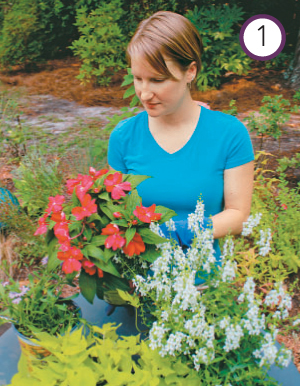
1 Select your plants. Container gardens need three types of plants: thrillers, fillers, and spillers. The pink SunPatien® in this group is the thriller, a stand-out plant. White angelonia is the filler, planted in odd numbers. Purple scaevola and chartreuse sweet potato vine are the spillers in this container.
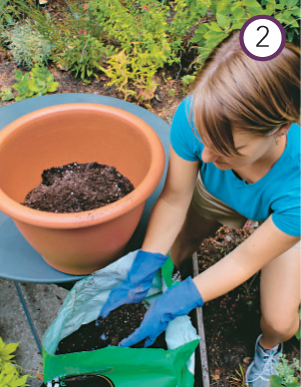
2 Fill your container halfway with potting soil. (The bag will be marked “potting soil.”) After you have the container half-full, you can begin placing your plants. Some plants will have larger rootballs than others, so you might should place the largest plant first then add additional soil to the container and place additional plants.
3 Finish placing your plants and add more soil to fill in the spaces between them. It’s important that the plant stems aren’t buried in soil so they don’t rot. That’s why you need to be careful when placing plants in the pots and place larger plants first. Don’t be afraid to really pack the container full of plants. Because you usually grow them for only one season, their spacing doesn’t matter as much.

4 Push the soil down at the edge of the container so that it is at least one inch below the edge of the pot. This leaves room for water to sit and soak in when you water the plant. If you fill the soil to the top of the container, it will all run out when you water the pot and will make a big mess. This is also a good time to sprinkle some slow-release fertilizer into the pot. Add it around the edges and on top of the soil—don’t sprinkle it on top of the plants.
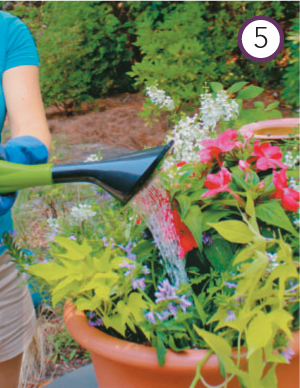
5 When you’ve finished planting, water the container. Give it a good soaking and let the water run out the bottom of the container. Then, wait several days to water again. A good rule of thumb is to water containers when the soil down to the second knuckle on your index finger (if you stick your finger in the pot) is dry. You should also water if the plants look droopy or saggy. Once the plants have grown to fill the pot, you’ll need to water once or twice a day.
Success Tip
Plant a true container “garden” by planting small trees and shrubs in some containers and annuals or perennials in others. Try something new with large tropical plants like palms or bird of paradise as part of your plant combination. Group these plants in different-sized containers on a patio or walkway. You’ll have an interesting movable garden that mimics the larger landscape.
What to Plant in Your Container
Colorful annual flowers are a sure bet for containers, but you can also grow vegetables, herbs, perennials, and trees in pots.
Herb garden: You can grow all of your kitchen herbs in two pots. In one pot, plant basil and mint together. They both like to be slightly moist. In the other pot, plant oregano, sage, thyme, and rosemary together. Let that pot dry out before watering.
Salad bowl: Plant salad greens, bunching onions, and even radishes in a large, shallow dish. You can “cut and come again” to your salad bowl for weeks as salad greens keep producing leaves.
Perennial garden in a pot: Create containers that last from season to season by planting a small tree or shrub surrounded by perennials.

Herbs

Perennials + Tree
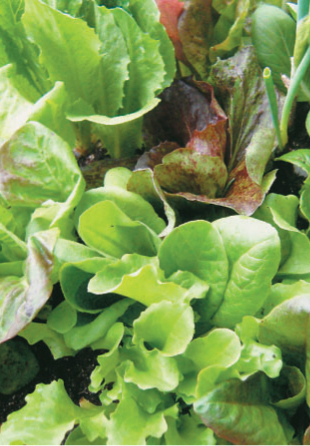
Salad garden
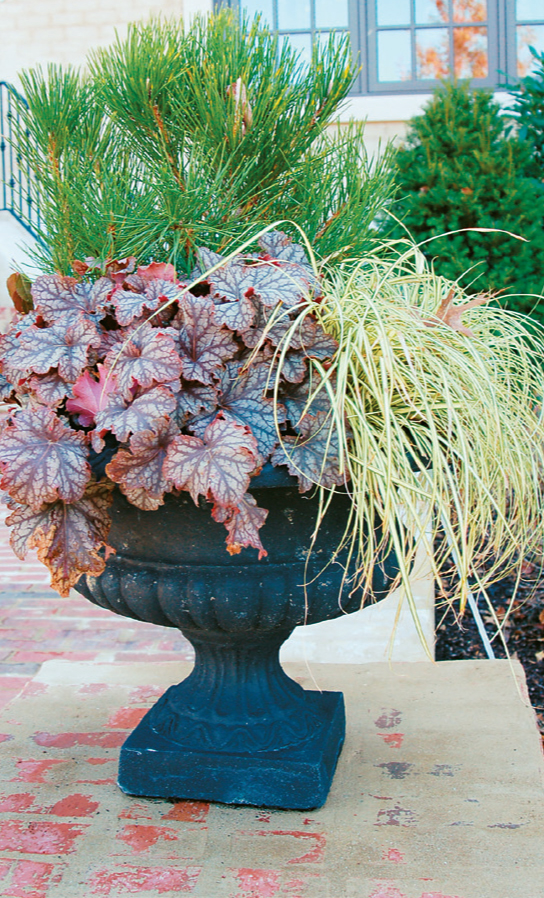
Perennials